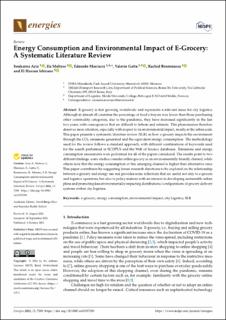| dc.description.abstract | E-grocery is fast growing worldwide and represents a relevant issue for city logistics. Although in almost all countries the percentage of food e-buyers was lower than those purchasing other commodity categories, due to the pandemic, they have increased significantly in the last two years, with consequences that are difficult to fathom and estimate. This phenomenon therefore deserves more attention, especially with respect to its environmental impact, mostly at the urban scale. This paper presents a systematic literature review (SLR) on how e-grocery impacts the environment through the CO2 emissions generated and the equivalent energy consumption. The methodology used for the review follows a standard approach, with different combinations of keywords used for the search performed in SCOPUS and the Web of Science databases. Emissions and energy consumption assessments were performed for all of the papers considered. The results point to two different findings: some studies consider online grocery as an environmentally friendly channel, while others note that the energy consumption of this emerging channel is higher than alternative ones. This paper contributes by suggesting future research directions to be explored on the relationship between e-grocery and energy use and provides some reflections that are useful not only to e-grocers and logistics operators, but also to policy makers with an interest in developing sustainable urban plans and promoting less environmentally impacting distributions/configurations of grocery delivery systems within city logistics. Keywords: e-grocery, energy consumption, environmental impact, city logistics, SLR | en_US |

